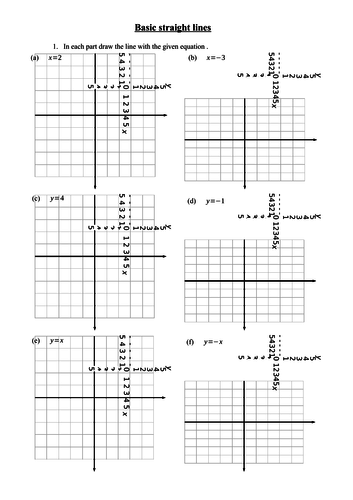

























I think this set of resources covers everything your classes need to learn and practice on straight line graphs (up to GCSE level). All the resources are suitable to be projected or printed for students to work on, saving a lot of time for drawing graphs and allowing them to annotate or work on diagrams. All resources come with solutions included.
Here is a brief description of each resource:
1. Basic straight lines - lines of the form x=a, y=a and y=x or y=-x
2. Drawing straight lines - 10 questions using the equation of a line y=mx+c to complete a table of values and draw the graph.
3. Cover-up method - 12 questions to practise drawing lines of the form ax+by=c
4. Using the equation - test if a point lies on a line, determine y-coord given x-coord and vice versa (70 questions)
5. Finding the gradient - 18 questions to practise finding gradients, including where the scales on the axes are not the same
6. Matching y=mx+c to the graph - they find the gradient and y-intercept for each given graph and equation, learning the connection between the equation and properties of the graph
7. Equation to gradient and y-intercept - simple worksheet to practice writing down the gradient and coordinates of y-intercept from the equation, and vice versa (24 questions)
8. Finding the equation of a line - 24 questions to practise finding the equation of the line from its graph, including where the scales on the axes are not the same
9. Finding equation using point and gradient - 10 questions to practise doing this with a grid as an aid, then 26 questions without a grid
10. Pairs of lines - 4 graphs, each with a pair of parallel or perpendicular lines. By finding the equation of each line the students should start to see the rules for gradients of parallel and perpendicular lines
11. Parallel and perpendicular lines - almost 50 questions finding the equation of a line parallel / perp to a given line that passes through (0,b) or (a, b)
12. Using two points A and B - find midpoint M of AB, gradient of line through A and B, equation of line through A and B, equation of line perp. to AB through A, B or M. 10 questions to learn the methods with grids as an aid, then an exercise for each style of question (over 50 questions in total).
13. Multiple choice questions - quick assessment covering most of the topic
14. Straight lines revision - 60 questions to revise the whole topic
15. Homework - 19 questions on all aspects of the topic, fully works solutions included
I have just worked through all these with my year 10 group and it took around 5 hours of lesson time to complete. A more able group may need less time but you have enough resources here to keep your classes busy for a number of lessons.
Something went wrong, please try again later.
This resource hasn't been reviewed yet
To ensure quality for our reviews, only customers who have purchased this resource can review it
Report this resourceto let us know if it violates our terms and conditions.
Our customer service team will review your report and will be in touch.
